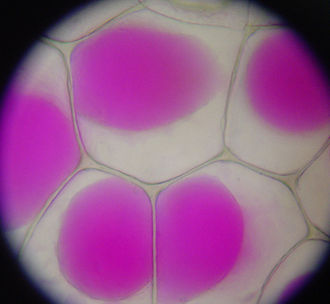Lysis
A biological process involving the breakdown of cells
Lysis[edit]

Lysis is a biological process involving the disintegration or destruction of a cell by rupture of the cell wall or membrane. This process can occur naturally or be induced artificially, and it is a critical concept in various fields of biology and medicine.
Mechanisms of Lysis[edit]
Lysis can occur through several mechanisms, depending on the type of cell and the external factors involved. The primary mechanisms include:
Osmotic Lysis[edit]
Osmotic lysis, also known as cytolysis, occurs when a cell takes in too much water, causing it to swell and burst. This is often seen in hypotonic environments where the concentration of solutes outside the cell is lower than inside, leading to water influx.
Enzymatic Lysis[edit]
Enzymatic lysis involves the breakdown of the cell wall or membrane by specific enzymes. For example, lysozyme is an enzyme that can degrade the peptidoglycan layer of bacterial cell walls, leading to lysis.
Viral Lysis[edit]
In viral lysis, bacteriophages or other viruses infect a host cell and replicate within it. Eventually, the host cell bursts, releasing new viral particles. This is a common method of viral propagation.
Applications of Lysis[edit]
Lysis is utilized in various scientific and medical applications, including:
Laboratory Techniques[edit]
In the laboratory, lysis is used to break open cells to extract DNA, RNA, or proteins for analysis. This is often achieved using chemical lysis buffers or mechanical disruption methods.
Medical Treatments[edit]
Lysis is also a target in medical treatments, such as in the use of antibiotics that induce bacterial lysis or in cancer therapy where tumor cells are targeted for destruction.
Plasmolysis[edit]

Plasmolysis is a specific type of lysis that occurs in plant cells. It involves the contraction of the cell membrane away from the cell wall due to the loss of water through osmosis. This process is typically observed when plant cells are placed in a hypertonic solution.
Related pages[edit]
Ad. Transform your life with W8MD's Budget GLP-1 injections from $75


W8MD offers a medical weight loss program to lose weight in Philadelphia. Our physician-supervised medical weight loss provides:
- Weight loss injections in NYC (generic and brand names):
- Zepbound / Mounjaro, Wegovy / Ozempic, Saxenda
- Most insurances accepted or discounted self-pay rates. We will obtain insurance prior authorizations if needed.
- Generic GLP1 weight loss injections from $75 for the starting dose.
- Also offer prescription weight loss medications including Phentermine, Qsymia, Diethylpropion, Contrave etc.
NYC weight loss doctor appointmentsNYC weight loss doctor appointments
Start your NYC weight loss journey today at our NYC medical weight loss and Philadelphia medical weight loss clinics.
- Call 718-946-5500 to lose weight in NYC or for medical weight loss in Philadelphia 215-676-2334.
- Tags:NYC medical weight loss, Philadelphia lose weight Zepbound NYC, Budget GLP1 weight loss injections, Wegovy Philadelphia, Wegovy NYC, Philadelphia medical weight loss, Brookly weight loss and Wegovy NYC
|
WikiMD's Wellness Encyclopedia |
| Let Food Be Thy Medicine Medicine Thy Food - Hippocrates |
Medical Disclaimer: WikiMD is not a substitute for professional medical advice. The information on WikiMD is provided as an information resource only, may be incorrect, outdated or misleading, and is not to be used or relied on for any diagnostic or treatment purposes. Please consult your health care provider before making any healthcare decisions or for guidance about a specific medical condition. WikiMD expressly disclaims responsibility, and shall have no liability, for any damages, loss, injury, or liability whatsoever suffered as a result of your reliance on the information contained in this site. By visiting this site you agree to the foregoing terms and conditions, which may from time to time be changed or supplemented by WikiMD. If you do not agree to the foregoing terms and conditions, you should not enter or use this site. See full disclaimer.
Credits:Most images are courtesy of Wikimedia commons, and templates, categories Wikipedia, licensed under CC BY SA or similar.
Translate this page: - East Asian
中文,
日本,
한국어,
South Asian
हिन्दी,
தமிழ்,
తెలుగు,
Urdu,
ಕನ್ನಡ,
Southeast Asian
Indonesian,
Vietnamese,
Thai,
မြန်မာဘာသာ,
বাংলা
European
español,
Deutsch,
français,
Greek,
português do Brasil,
polski,
română,
русский,
Nederlands,
norsk,
svenska,
suomi,
Italian
Middle Eastern & African
عربى,
Turkish,
Persian,
Hebrew,
Afrikaans,
isiZulu,
Kiswahili,
Other
Bulgarian,
Hungarian,
Czech,
Swedish,
മലയാളം,
मराठी,
ਪੰਜਾਬੀ,
ગુજરાતી,
Portuguese,
Ukrainian